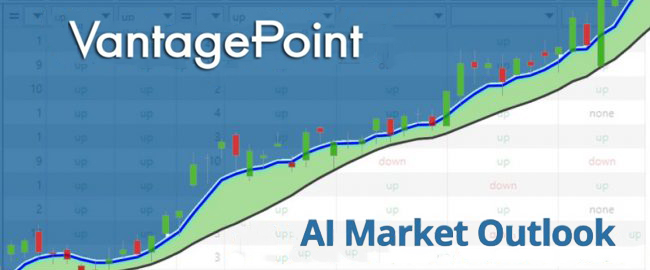Can Your Trading Strategy Pass a Breathalyzer Test?
How do you define opportunity in trading? That is a major foundational question which all traders need to clearly ask themselves. It is always important to look at what causes trading behavior. Most traders lose money. This is factual, and yet most traders don’t ask why.
An old friend of mine was an addicted gambler. He loved gambling on all games of chance. What started out as a hobby became an obsession and eventually an addiction that was ruining his life. When I asked him about his addiction, he basically explained that it was all about hope. For him, when the dice were in the air there was hope and he thought being addicted to hope was a very good thing. That imagery really explained a lot. One could understand the nature of the problem and how the dopamine rush that came with winning was perceived as a larger reward than any of the losses incurred financially.
I think many traders wrestle with similar demons. In the financial markets we refer to it as “HOPIUM,” which is an addiction to false hopes and romanticizing the struggle associated with success.
With the technology that is available today, it does not need to be hard!
When I ask traders to concisely explain their trading strategy to me, I usually get black stares. Occasionally someone will reply with something they heard or read about in the financial media which they decided to pursue. Every now and then someone will talk about one indicator that they use occasionally. But most of the time, traders take a trade because they heard or read something somewhere that sounded credible. That’s downright terrifying!
The sad reality is that better than 65% of traders draw down their trading accounts more than 50% in their first 100 trades. Like amateur poker players, they live for the thrill of going, “ALL IN.” You need to understand this at the outset of trading if you genuinely want to be successful.
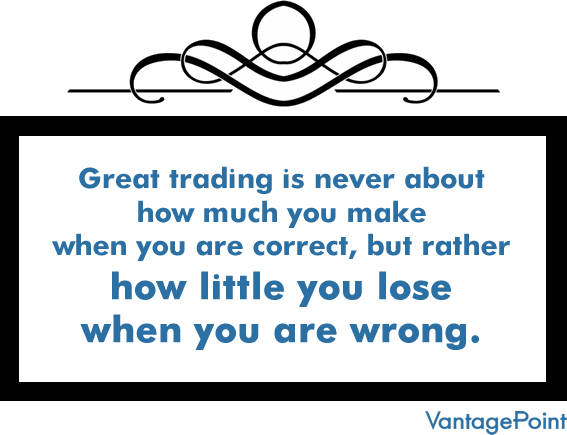
Here is a simple question that you need to get clear on –
What is it that you really, really, really want from the markets?
(Notice I said REALLY three times).
I promise not to be your psychologist here.
However, I will share with you my experience of working with traders while I was a broker – Most traders DO NOT WANT TO WIN.
They will tell you differently and they can be super convincing, but their behavior will tell you otherwise. And you can always tell the truth by following the money and studying the results.
I’m convinced that most traders are in the markets because they want ACTION.
They want adrenalin.
They want the excitement than comes with a big score.
Or they want the thrill of being on the wrong side of a roadkill but living to talk about it.
Many traders are in the markets because they love to play the victim role which earns them the role of storyteller.
In other words, most traders love the thrill of gambling, and their results are predictable. Like my friend dealing with a gambling addiction, if the dice were in mid-air there was “hope,” so these traders have numerous big trades in mid-air” at all times.
The markets will give you whatever you really, really, really want.
If you want ACTION, the market is a great place to get your addiction.
If you want wisdom you need to understand statistical probabilities and trends.
Your trading education isn’t how much you have committed to memory, or even how much you know. It’s being able to differentiate between what you know and what you don’t.
There are a couple of important questions that you need great answers to if your trading strategy is going to pass the ‘breathalyzer test.’ Trading on false hope is a sure-fire way to lose money. Trading with a disregard to risk is a recipe for disaster.
- How do you define the trend?
- What is the best case and worst-case scenario for the asset that you are considering trading over the past year?
- Where is the asset trading in relation to its 52-week range?
- How do you evaluate and define risk?
- What is the probability of success if you take this trade?
- What is the risk reward ratio on this trade?
The artificial intelligence answers all these questions for traders. This goes a long way in helping traders manage their emotions when they are in the markets. Why? The key word is consistency. This consistency is achieved by quantifying all aspects of a trade.
The main problem of trading is the organization of information so that effective trading decisions can be made. If you have a valid process where the probabilities are favorable to you, the reality is that you have to learn to trade consistently. By doing so, you allow the compounding of gains.
You can summarize these six questions with simply two words which in my opinion is what keeps great traders focused.
Those words are “What IF?”
Trading is all about answering the WHAT IF question.
What if you are wrong? At what point do you take your losses?
What if you are right? Do you have a strategy to add to your winning position?
In other words, what do you stand to make if you are correct?
And how much will you lose if you are wrong?
If you get that answer right, you are in it for the long term. Get it wrong and you are assured to run with the losers.
Defense Is Much More Important Than Offense.
Great Traders Protect Their Equity Above All Else.
Offensive Traders Quickly Discover That MARKETS Are Often Humbling Mechanisms.
Here at Vantagepoint AI, we have dealt with thousands and thousands of traders every year. We have come to understand exceptionally well the pitfalls and stumbling blocks that traders face every day in the financial markets. Here is a short list of the most frequent and damaging errors that most traders and investors make.
- Very poor market selection criteria. They don’t know what to look for to find a trending market.
- Miserable results are often the result of continuing to “buy more” of a lousy company on the way down. If the trend is down, why are you buying more of it? Thinking that something is cheap in a down market is a surefire way to go poor.
- Most new traders love to try and buy low and sell high. While this is a famous Wall Street adage, it is more important to find a great market and learn to buy high and sell higher.
- The public loves to buy cheap stocks and fantasizes about making a killing. So, they load up and buy a few thousand shares of a $1 stock and “hope for the best.” Particularly today when you can buy partial shares traders and investors need to learn how to define quality and buy that instead. Would you rather have one share of APPLE or 5000 share of some no-name penny stock?
- Wanting too much, too fast and overleveraging your trading account. Unless you are a seasoned professional you can’t handle the leverage. Learn how to trade with zero leverage before you try and swing for the fences. Don’t overtrade!
- Newbies to the financial markets love to buy on rumors, tips, stories which are unfounded. Stories are opinions disguised as facts. Trade the facts based upon what price is doing.
- Over 95% of market participants are afraid to buy an asset when it is going to new 52-week highs. The price seems to high for them and the stock continues to run. Make the trend your friend. Look at any great investment and you’ll see that the way greatness was defined was a company that consistently was making new 52-week highs.
- Most investors and traders stubbornly hold on to losers and sell their winners too soon. This is the exact opposite behavior of seasoned professionals. In trading success is accomplished by holding on that which rewards you and disposing of that which hurts you.
- Most investors and traders lack a repeatable method of finding great trends that they can exploit. Show me a trader who just banked a huge profit, and I will show you a trader in need of a dopamine/adrenalin rush. How are you going to find the next great trade?
- Most investors do not understand or practice good money management. They invest a huge part of their portfolio in one or two assets and hope for the best. It is much more important to diversify your bankroll into multiple potential trading opportunities all of smaller sizes. Watch any professional money manager and you will quickly discover that trade size is the most important aspect of trading.
But here’s the bigger lesson and why I bring this up.
If you are stressed out trading and not getting exceptional results, there is a better way!
Let me share a few charts to demonstrate this simple point:
What do you see here?
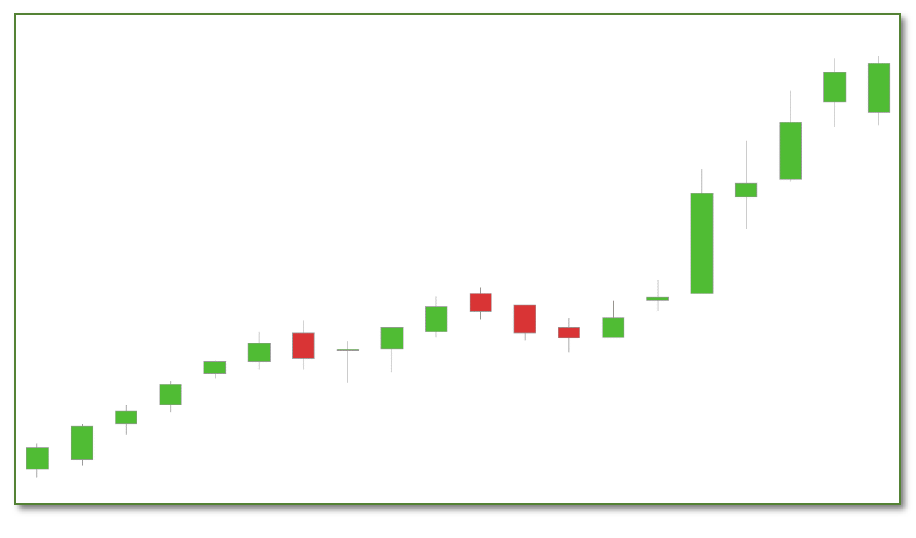
If you see an UPTREND or rising market, please go to the head of the class. ? This market “IS” rising.
What do you see here?
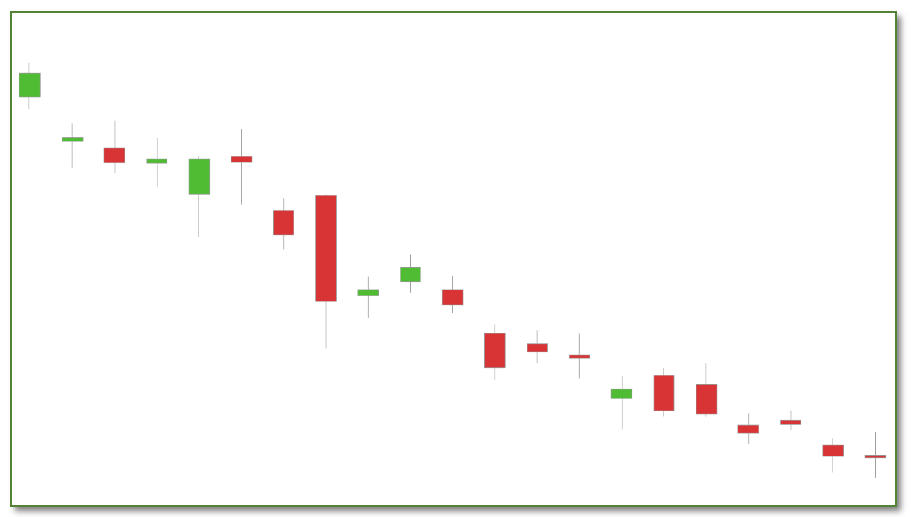
If you said this market is falling you have 20/20 vision.
What do you see here?
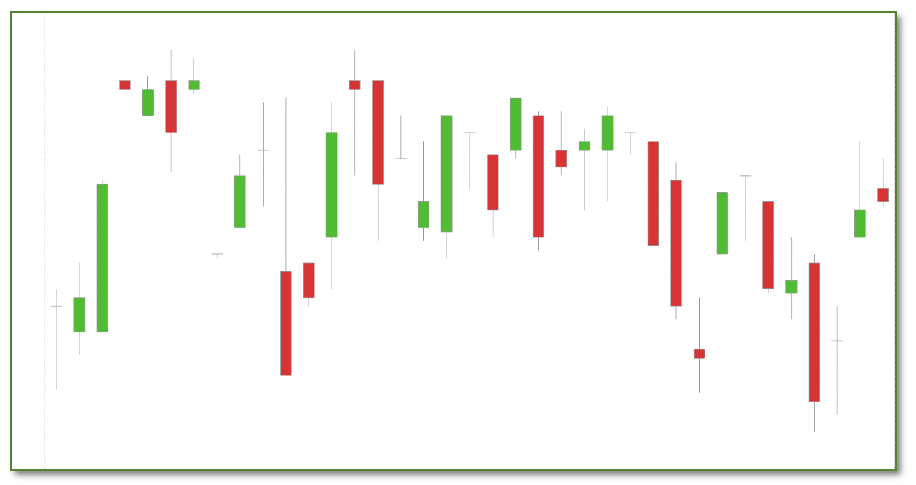
If you said, this stock “IS” trading sideways, you get extra brownie points. ?
It sounds very elementary and obvious. But overlooking the obvious things often hurt a trader’s portfolio.
The basics are regularly overlooked by inexperienced traders when they hear a story about a company that has all the elements of the next superstock.
It is very sad, and unnecessary in today’s day and age of machine learning and artificial intelligence.
- A stock may have a very alluring story.
- A stock may have a very effective management team.
- A stock may have incredible earnings.
- A stock may have infrastructure, partnerships, uniqueness, etc.
But, if these elements are not reflected in the price, you are focused on what “SHOULD” occur in the market.
I would like to point out that the word SHOULD is responsible for more losses in trading than any other.
I can show you hundreds of companies with amazing press releases and publicity that “SHOULD” be the next APPLE, Amazon, or Google. Unfortunately, that is not the way markets work.
Bad traders obsess on the SHOULD. Every other word out of their mouth’s is SHOULD.
If only I had just a nickel for how many times a trader has told me all the reasons why his portfolio is heavily invested in a stock because of a great story, in spite of the stock being in a firm downtrend! It’s horribly painful to listen to because I know it doesn’t have to be that way.
The beauty of neural networks, artificial intelligence and machine learning are that they are fundamentally focused on pattern recognition to determine the best move forward. When these technologies flash a change in forecast – pay attention, it is newsworthy.
We often do not understand why something is occurring but that does not mean that we cannot take advantage of it.
Remember What’s Important.
Price is the only thing that matters when we are trading. It is what can make you wealthy or decimate your account. Everything else is just noise.
Are you capable of finding those markets with the best risk/reward ratios out of the thousands of trading opportunities that exist?
Knowledge.
Useful knowledge.
And its application is what A.I. delivers.
Here are two charts that the artificial intelligence has been focused on over the past six months for Vantagepoint Power Traders.
First is MODERNA (MRNA) which we have been monitoring very closely all year. You can read our stock studies on MRNA here and here. Over the last 6 months it is up over 210% Markets like this are what traders live for because they can create legacy wealth.
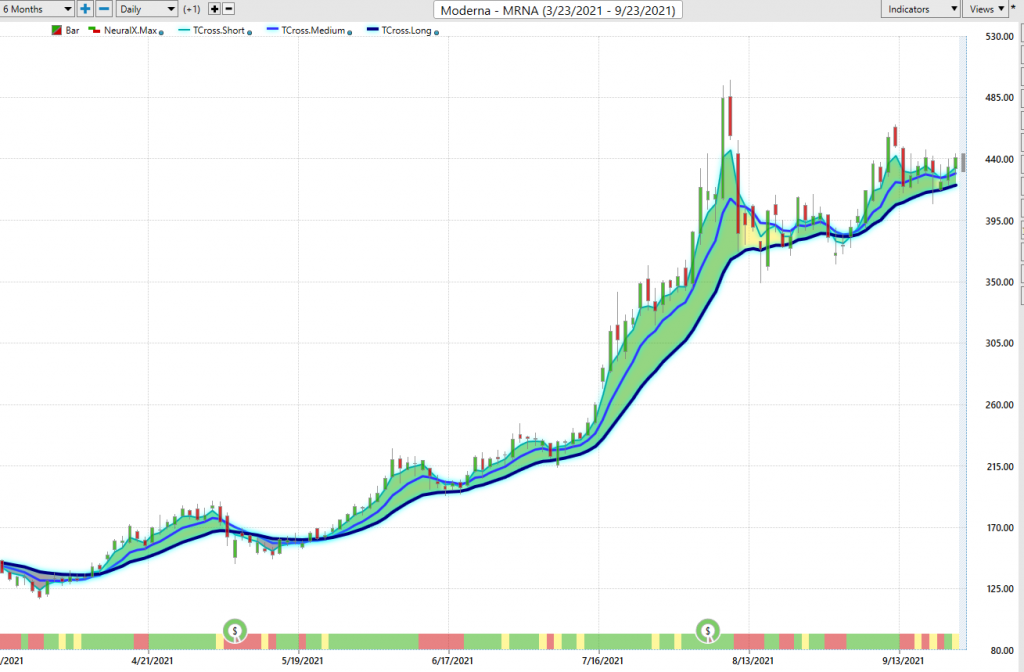
Second, is another amazing trend that has rewarded Power Traders over the past 6 months. This is the biotech stock Regeneron which we discussed in August in a weekly stock study.
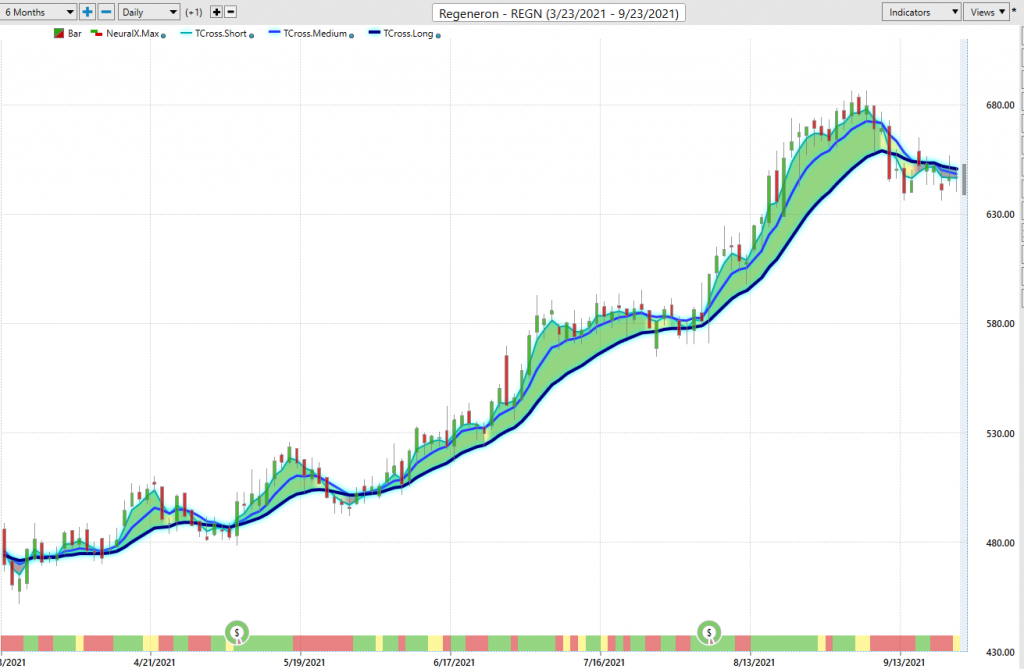
Let these two markets sink in for a moment.
Isn’t that what we all want from the markets? Consistency.
So, imagine what your portfolio would look like today had you applied artificial intelligence to it five years ago?
All of our customers were skeptics until they saw for themselves how a machine-based learning software makes it easier to find statistically solid trends and generates better returns with less risk.
Most traditional indicators that traders use today were developed in the 1970’s and 1980’s. They are incapable of telling you what the market is going to do moving forward.
Once again, machine outperforms humanoid.
It’s important that you find out more. Join us for a FREE, Live Training. We’ll show you at least three stocks that have been identified by the A.I. that are poised for big movement… and remember, movement of any kind is an opportunity for profits!
Discover why artificial intelligence is the solution professional traders go-to for less risk, more rewards, and guaranteed peace of mind.
Visit with us and check out the A.I. at our Next Live Training.
It’s not magic. It’s machine learning.
Make it count.
THERE IS A SUBSTANTIAL RISK OF LOSS ASSOCIATED WITH TRADING. ONLY RISK CAPITAL SHOULD BE USED TO TRADE. TRADING STOCKS, FUTURES, OPTIONS, FOREX, AND ETFs IS NOT SUITABLE FOR EVERYONE.IMPORTANT NOTICE!
DISCLAIMER: STOCKS, FUTURES, OPTIONS, ETFs AND CURRENCY TRADING ALL HAVE LARGE POTENTIAL REWARDS, BUT THEY ALSO HAVE LARGE POTENTIAL RISK. YOU MUST BE AWARE OF THE RISKS AND BE WILLING TO ACCEPT THEM IN ORDER TO INVEST IN THESE MARKETS. DON’T TRADE WITH MONEY YOU CAN’T AFFORD TO LOSE. THIS ARTICLE AND WEBSITE IS NEITHER A SOLICITATION NOR AN OFFER TO BUY/SELL FUTURES, OPTIONS, STOCKS, OR CURRENCIES. NO REPRESENTATION IS BEING MADE THAT ANY ACCOUNT WILL OR IS LIKELY TO ACHIEVE PROFITS OR LOSSES SIMILAR TO THOSE DISCUSSED ON THIS ARTICLE OR WEBSITE. THE PAST PERFORMANCE OF ANY TRADING SYSTEM OR METHODOLOGY IS NOT NECESSARILY INDICATIVE OF FUTURE RESULTS. CFTC RULE 4.41 – HYPOTHETICAL OR SIMULATED PERFORMANCE RESULTS HAVE CERTAIN LIMITATIONS. UNLIKE AN ACTUAL PERFORMANCE RECORD, SIMULATED RESULTS DO NOT REPRESENT ACTUAL TRADING. ALSO, SINCE THE TRADES HAVE NOT BEEN EXECUTED, THE RESULTS MAY HAVE UNDER-OR-OVER COMPENSATED FOR THE IMPACT, IF ANY, OF CERTAIN MARKET FACTORS, SUCH AS LACK OF LIQUIDITY. SIMULATED TRADING PROGRAMS IN GENERAL ARE ALSO SUBJECT TO THE FACT THAT THEY ARE DESIGNED WITH THE BENEFIT OF HINDSIGHT. NO REPRESENTATION IS BEING MADE THAT ANY ACCOUNT WILL OR IS LIKELY TO ACHIEVE PROFIT OR LOSSES SIMILAR TO THOSE SHOWN.









